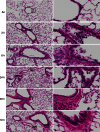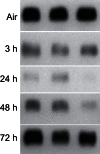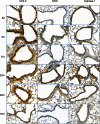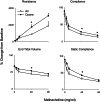Ozone-induced injury and oxidative stress in bronchiolar epithelium are associated with altered pulmonary mechanics
- PMID: 23492811
- PMCID: PMC3663562
- DOI: 10.1093/toxsci/kft071
Ozone-induced injury and oxidative stress in bronchiolar epithelium are associated with altered pulmonary mechanics
Abstract
In these studies, we analyzed the effects of ozone on bronchiolar epithelium. Exposure of rats to ozone (2 ppm, 3 h) resulted in rapid (within 3 h) and persistent (up to 72 h) histological changes in the bronchiolar epithelium, including hypercellularity, loss of cilia, and necrotizing bronchiolitis. Perivascular edema and vascular congestion were also evident, along with a decrease in Clara cell secretory protein in bronchoalveolar lavage, which was maximal 24 h post-exposure. Ozone also induced the appearance of 8-hydroxy-2'-deoxyguanosine, Ym1, and heme oxygenase-1 in the bronchiolar epithelium. This was associated with increased expression of cleaved caspase-9 and beclin-1, indicating initiation of apoptosis and autophagy. A rapid and persistent increase in galectin-3, a regulator of epithelial cell apoptosis, was also observed. Following ozone exposure (3-24 h), increased expression of cyclooxygenase-2, inducible nitric oxide synthase, and arginase-1 was noted in bronchiolar epithelium. Ozone-induced injury and oxidative stress in bronchiolar epithelium were linked to methacholine-induced alterations in pulmonary mechanics. Thus, significant increases in lung resistance and elastance, along with decreases in lung compliance and end tidal volume, were observed at higher doses of methacholine. This indicates that ozone causes an increase in effective stiffness of the lung as a consequence of changes in the conducting airways. Collectively, these studies demonstrate that bronchiolar epithelium is highly susceptible to injury and oxidative stress induced by acute exposure to ozone; moreover, this is accompanied by altered lung functioning.
Keywords: bronchiole; epithelium; oxidative stress; ozone; pulmonary mechanics.
Figures







Similar articles
-
Classical and alternative macrophage activation in the lung following ozone-induced oxidative stress.Toxicol Appl Pharmacol. 2012 Sep 1;263(2):195-202. doi: 10.1016/j.taap.2012.06.009. Epub 2012 Jun 19. Toxicol Appl Pharmacol. 2012. PMID: 22727909 Free PMC article.
-
Mechanism underlying acute lung injury due to sulfur mustard exposure in rats.Toxicol Ind Health. 2016 Aug;32(8):1345-1357. doi: 10.1177/0748233714560603. Epub 2014 Dec 23. Toxicol Ind Health. 2016. PMID: 25537624
-
Consequences of prolonged inhalation of ozone on F344/N rats: collaborative studies. Part IX: Changes in the tracheobronchial epithelium, pulmonary acinus, and lung antioxidant enzyme activity.Res Rep Health Eff Inst. 1995 Mar;(65 Pt 8-9):41-98; discussion 99-110. Res Rep Health Eff Inst. 1995. PMID: 7619334
-
Acute Respiratory Barrier Disruption by Ozone Exposure in Mice.Front Immunol. 2019 Sep 13;10:2169. doi: 10.3389/fimmu.2019.02169. eCollection 2019. Front Immunol. 2019. PMID: 31608051 Free PMC article. Review.
-
Ozone- and endotoxin-induced mucous cell metaplasias in rat airway epithelium: novel animal models to study toxicant-induced epithelial transformation in airways.Toxicol Lett. 1993 May;68(1-2):251-63. doi: 10.1016/0378-4274(93)90136-l. Toxicol Lett. 1993. PMID: 8516771 Review.
Cited by
-
Differential expression of pro-inflammatory and oxidative stress mediators induced by nitrogen dioxide and ozone in primary human bronchial epithelial cells.Inhal Toxicol. 2016 Jul;28(8):374-82. doi: 10.1080/08958378.2016.1185199. Inhal Toxicol. 2016. PMID: 27206323 Free PMC article.
-
Epigenetic regulation of TIMP1 expression by 8-oxoguanine DNA glycosylase-1 binding to DNA:RNA hybrid.FASEB J. 2019 Dec;33(12):14159-14170. doi: 10.1096/fj.201900993RR. Epub 2019 Oct 25. FASEB J. 2019. PMID: 31652414 Free PMC article.
-
Role of NOS2 in pulmonary injury and repair in response to bleomycin.Free Radic Biol Med. 2016 Feb;91:293-301. doi: 10.1016/j.freeradbiomed.2015.10.417. Epub 2015 Oct 23. Free Radic Biol Med. 2016. PMID: 26526764 Free PMC article.
-
Alterations in the proteome of the respiratory tract in response to single and multiple exposures to naphthalene.Proteomics. 2015 Aug;15(15):2655-68. doi: 10.1002/pmic.201400445. Epub 2015 May 13. Proteomics. 2015. PMID: 25825134 Free PMC article.
-
Protective effect of selegiline on cigarette smoke-induced oxidative stress and inflammation in rat lungs in vivo.Ann Transl Med. 2020 Nov;8(21):1418. doi: 10.21037/atm-20-2426. Ann Transl Med. 2020. PMID: 33313163 Free PMC article.
References
-
- Aoshiba K., Koinuma M., Yokohori N., Nagai A. (2003). Immunohistochemical evaluation of oxidative stress in murine lungs after cigarette smoke exposure. Inhal. Toxicol. 15, 1029–1038 - PubMed
-
- Bates J. H., Lauzon A. M. (2007). Parenchymal tethering, airway wall stiffness, and the dynamics of bronchoconstriction. J. Appl. Physiol. 102, 1912–1920 - PubMed
-
- Bates J. H., Lutchen K. R. (2005). The interface between measurement and modeling of peripheral lung mechanics. Respir. Physiol. Neurobiol. 148, 153–164 - PubMed
-
- Broeckaert F., Clippe A., Wattiez R., Falmagne P., Bernard A. (2003). Lung hyperpermeability, Clara-cell secretory protein (CC16), and susceptibility to ozone of five inbred strains of mice. Inhal. Toxicol. 15, 1209–1230 - PubMed
-
- Cai Y., Kumar R. K., Zhou J., Foster P. S., Webb D. C. (2009). Ym1/2 promotes Th2 cytokine expression by inhibiting 12/15(S)-lipoxygenase: Identification of a novel pathway for regulating allergic inflammation. J. Immunol. 182, 5393–5399 - PubMed
Publication types
MeSH terms
Substances
Grants and funding
LinkOut - more resources
Full Text Sources
Other Literature Sources
Medical
Research Materials
Miscellaneous

